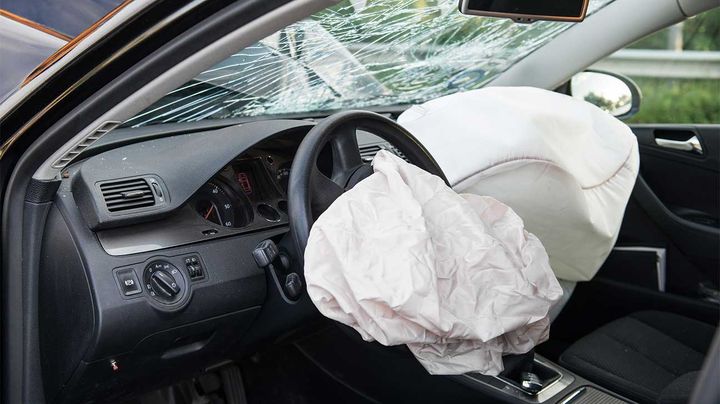


Airbags are a crucial safety feature in modern vehicles, designed to inflate rapidly during a collision and cushion the impact for the driver and passengers. However, once an airbag deploys, it raises significant concerns about the safety and legality of continuing to drive the vehicle. This comprehensive article will delve into the conditions under which airbags deploy, the potential risks and consequences of driving with deployed airbags, the steps to take after an airbag deployment, the replacement process, costs, and alternatives, as well as expert advice and recommendations.

Airbags are designed to deploy in specific situations based on the severity and type of collision. The deployment is triggered by sensors that detect sudden deceleration or impact forces above a certain threshold. This section will explore when airbags deploy and the mechanisms behind their deployment.
Airbags deploy in the following situations:
| Airbag Type | Deployment Conditions |
|---|---|
| Frontal Airbags | Moderate to severe frontal or near-frontal crashes |
| Side Airbags | Side-impact collisions or rollovers |
The deployment process is initiated by sensors strategically placed throughout the vehicle, which detect the severity and direction of the impact. Once the sensors detect a collision force above the deployment threshold, they send a signal to the airbag control module, triggering the rapid release of an inflator gas that inflates the airbag within milliseconds.
While there is no specific law prohibiting driving a car with deployed airbags, it is generally not recommended due to significant safety concerns. Most automotive experts and authorities strongly advise against driving with deployed airbags, as it can compromise the vehicle's safety systems and increase the risk of further injuries or accidents.
Driving with deployed airbags can pose several risks and potential consequences, including:
Lack of protection in case of another collision
Obstructed vision, increasing the risk of accidents
Potential injuries from the deployed airbag or impact
Additional damage to the vehicle's interior components
It is crucial to weigh the risks against the convenience of driving with deployed airbags. Authorities may consider it negligence or reckless behavior, potentially leading to fines or legal consequences in the event of an accident or traffic violation.
Driving with deployed airbags can increase the risk of various injuries and damages, including:
| Injury/Damage | Description |
|---|---|
| Airbag-Related Injuries | Burns, abrasions, or impact injuries from the deployed airbag |
| Respiratory Issues | Irritation or respiratory problems caused by chemicals released during deployment |
| Obstructed Vision | Increased risk of accidents due to obstructed view of the road |
| Interior Damage | Damage to the dashboard, steering wheel, or other interior components |
The rapid inflation and deflation of the airbag can cause burns, abrasions, or impact injuries if it comes into contact with the occupants while driving. Additionally, the chemicals released during deployment can cause respiratory issues or irritation if inhaled, especially for individuals with pre-existing respiratory conditions or sensitivities.
Deployed airbags can significantly obstruct the driver's view of the road, increasing the risk of accidents and collisions. Continuing to drive with deployed airbags can also cause further damage to the vehicle's interior components, resulting in costly repairs.
If you find yourself in a situation where your airbags have deployed, it is crucial to take the following immediate steps:

Call Emergency Services (if needed): If anyone is injured during the collision, seek medical attention immediately by calling emergency services.
Move Vehicle to Safe Location: If possible, move the vehicle to a safe location away from traffic or potential hazards to prevent further accidents or incidents.
Contact Insurance Company: Contact your insurance company promptly and report the incident, providing detailed information about the collision, airbag deployment, and any damages or injuries.
Have Vehicle Towed for Inspection and Repair: Do not attempt to drive the vehicle until the airbags have been replaced and the vehicle has been deemed safe to operate. Have the vehicle towed to a repair shop or dealership for inspection and airbag replacement.
The airbag replacement process involves several steps to ensure the proper functioning of the airbag system:
Removing Deployed Airbag and Damaged Components: The first step is to remove the deployed airbag and any damaged components, which may involve removing the steering wheel, dashboard, or other interior parts.
Replacing Airbag Module, Sensors, and Related Parts: Once the deployed airbag is removed, the airbag module, sensors, and any other related parts must be replaced with new components.
Resetting System and Diagnostic Tests: After the new airbag components are installed, the airbag system must be reset and undergo diagnostic tests to ensure proper functioning, including calibrating the sensors and testing the deployment mechanisms.
The cost of airbag replacement can vary significantly depending on several factors:
| Factor | Description |
|---|---|
| Vehicle Make and Model | Costs can vary based on the specific vehicle |
| Number of Airbags Deployed | More deployed airbags increase the replacement cost |
| Additional Damage | Extent of any additional damage to the vehicle |
On average, expect to pay between $1,000 and $6,000 for airbag replacement and related repairs.
Most auto insurance policies cover airbag replacement costs if the deployment was caused by a covered incident, such as a collision. However, the insurance company may consider the vehicle a total loss if the repair costs, including airbag replacement, exceed the vehicle's value.
It is essential to contact your insurance company promptly after an airbag deployment and follow their claims process. Provide detailed documentation, including photos and repair estimates, to support your claim.
If you cannot immediately have the airbags replaced, consider the following alternatives to avoid driving with deployed airbags:
Towing Services: Have the vehicle towed to a repair shop or dealership to eliminate the risks associated with driving with deployed airbags.
Rental Cars: Rent a temporary vehicle until your car's airbags can be replaced, providing a safe and convenient option for transportation.
Ride-Sharing and Public Transportation: Use ride-sharing services or public transportation until your vehicle is repaired, eliminating the need to drive with deployed airbags.
Automotive experts and safety organizations strongly advise against driving a car with deployed airbags due to the potential risks and safety concerns.
| Expert/Organization | Recommendation |
|---|---|
| Certified Automotive Technician | "Driving with deployed airbags is extremely dangerous and should be avoided at all costs. Not only are you putting yourself and others at risk, but you may also be liable for any accidents or injuries that occur." |
| National Highway Traffic Safety Administration (NHTSA) | "Airbags are designed to save lives, but they can only do their job once. Driving with deployed airbags compromises your safety and the safety of others on the road." |
Prioritizing safety and following expert recommendations can help prevent further injuries, accidents, and costly repairs. By understanding the legalities, risks, and alternatives, drivers can make informed decisions and take appropriate actions after an airbag deployment.
While the decision to drive with deployed airbags may seem convenient, it is strongly advised against due to the significant potential risks and safety concerns. Airbags are designed to protect occupants during a collision, but driving with deployed airbags compromises this crucial safety feature and increases the risk of further injuries, accidents, and vehicle damage.
By understanding the legalities, potential consequences, and alternatives, drivers can make informed decisions and take appropriate actions after an airbag deployment. Prioritizing safety and following expert recommendations is crucial to prevent further harm and ensure the well-being of all occupants and other road users.
Airbags are designed to deploy when sensors detect a sudden deceleration or impact force above a certain threshold, typically in moderate to severe frontal or side-impact collisions. The deployment is triggered by the vehicle's airbag control module.
Yes, in rare cases, airbags can deploy without an actual collision if the sensors malfunction or detect sudden braking or abrupt stopping as a potential impact.
No, airbags are designed for single use only. Once deployed, they must be replaced with new airbag components before the vehicle can be driven again.
Airbags inflate extremely rapidly, typically within 20 to 30 milliseconds after the deployment signal is received from the sensors.
Yes, the force of airbag deployment can potentially cause injuries, especially to children or smaller adults who are seated too close to the airbag module when it inflates.
While there is no specific law prohibiting driving with deployed airbags, it is generally not recommended due to the lack of protection in case of another collision and the potential for obstructed vision or additional injuries.
The cost of airbag replacement can vary significantly, ranging from $1,000 to $6,000 or more, depending on the vehicle make and model, the number of airbags deployed, and any additional damage.
Most auto insurance policies with comprehensive or collision coverage will cover the cost of airbag replacement if the deployment was caused by a covered incident, such as a collision or other covered event.
In some cases, certain components of the airbag system, such as the control module or sensors, may be eligible for repair instead of complete replacement, potentially reducing the overall cost.
Deployed airbags should be properly disposed of or recycled according to local regulations, as they may contain hazardous materials or chemicals used in the deployment process.

Sarah isn't your average gearhead. With a double major in Mechanical Engineering and Automotive Technology, she dived straight into the world of car repair. After 15 years of turning wrenches at dealerships and independent shops, Sarah joined MICDOT to share her expertise and passion for making cars run like new. Her in-depth knowledge and knack for explaining complex issues in simple terms make her a valuable asset to our team.













